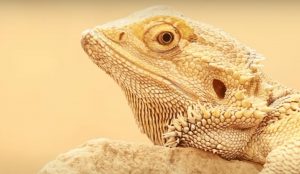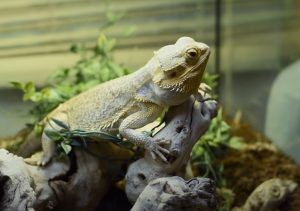How do bearded dragons sleep?
Bearded dragons come from deserts in Australia. Unlike other nocturnal reptiles, they are diurnal animals that are active during the day and sleep at night.
Some of them have a lot of behaviors, which is so cute that you will burst out laughing once you see them.
If you have a bearded dragon, you will easily understand how bearded dragons sleep as well as their strange sleeping habits below.
Related Posts:
- Do Beardies Get Lonely?
- Safe and Harmful Plants for Beardie
- How Long Can a Beardie Go Without Water?
- Beardie Humidity Level
How Long Should Bearded Dragons Sleep?

Typically, bearded dragons wake up as the sun is up and goes to sleep as it becomes darker.
A bearded dragon usually sleeps around 8 to 12 hours per day and it depends on the temperature or the seasons.
The higher the temperature, the more time they spend sleeping.
They usually sleep around 12 hours in winter and 14 hours in an extremely hot summer.
That means bearded dragons are sleeping a lot in summer.
If your bearded dragon can sleep on the right schedule for a long time, that helps their health better in the future.
There is no need for any light when the bearded dragon is supposed to sleep.
A flashlight or the light from your mobile phone can disrupt their sleep.
Remember to switch all the lights off as it is the best way to help them experience a long sleep.
Why Must Bearded Dragons Sleep Long Hours?
A baby bearded dragon must sleep the same amount of time as an adult bearded dragon does, which helps him maintain good health, grow at the most rapid rate, and reduce stress.
You have to take him to get used to sleeping in a day-night circle of the sun rising or setting.
Make sure that he will go to sleep as well as wake up at the same time each day.
The baby beardie will grow up to full of length in the first 12 months. It estimates 16 inches to 22 inches. A bearded dragon reaches their maximum length in a short time.
In this stage of their life, the bearded dragon must adhere to a strict bedtime routine to get good conditions to grow.
Do Bearded Dragons Dream in Deep Sleep?
According to the newest report, the reptile may dream and have a deep sleep with rapid eye movement and slow-wave stage, just like humans. Until now, only birds and mammals such as humans may have this behavior.
When a person who is falling asleep rapidly moves his eyes, their heart rate rises and the muscle is out of control. Finally, their dream is coming soon.
What is a bearded dragon’s dream? If someone asks me something like that, I just respond to them with a friendly smile and say, “I don’t know.”
Do Bearded Dragons Sleep With Their Eyes Closed or Open?

Some people try their best to observe a bearded dragon when he sleeps, then they see that his eyes are closed just like humans.
Is it right for everyone?
According to the newest reports, most of bearded dragons sleep with closed eyes. However, if there is any light, they will open their eyes.
That said, turn the lights off completely including the red light to avoid disturbing their sleep.
Many bearded dragons close their eyes in various situations.
For instance, when you hold it on your arm for too long, the first thing they do is that they close their eyes to protect themselves.
On the contrary, these behaviors indicate that they are not comfortable.
Read More:
- Can Beardies Eat Radish Greens?
- Can Beardies Eat Honeydew Melon?
- Do Beardies Eat Brussel Sprouts?
- Can Beardies Eat Squash?
- Can Beardies Eat Peas?
3 Strange Sleeping Habits of Bearded Dragons

1. Uses Sand as a Blanket
If you see a bearded dragon has covered itself with sand, don’t be surprised.
This is normal for them, just like you with a blanket at night. They lie under the sand to regulate their body temperature and block the direct sunshine.
There is one other reason for digging in the sand of the bearded dragon.
Maybe you just got a new beardie. They have not adapted to a new environment, and they have to learn how to get used to some new friends.
They are digging a hole to hide from other dominant bearded dragons, if any.
2. Strange Positions

Many bearded dragons usually lie on their stomach just like any animal. However, there are other postures they may use daily.
In the wild, bearded dragons are slightly arboreal, so they have an awkward sleeping posture: a vertical sleeping position.
It’s not rare to see a bearded dragon falling asleep with their fingers against the glass in the vertical position.
Read More:
3. Sleeping All Day Long

Like any reptile, a bearded dragon also prepares for winter’s sleep.
When winter comes, a bearded dragon will be likely to start a brumation, which is a natural process.
They also have several symptoms such eating less, finding a safe corner to hide, or stopping basking.
If the temperature of the tank is too low, it won’t be able to digest its food and maintain its good health.
They tend to sleep a lot or all day instead of doing activities such as basking and eating.
The UVB light plays an important role in their development.
A suitable UVB light mode is needed to help the bearded dragon to absorb vitamin D3 and calcium, but don’t use UVB light when they are falling asleep, which disturbs their sleep.
If the temperature drops very low, you can use a heat controller.
Read More:
Conclusion
Bearded dragons sleep in very strange ways, aren’t they?
Even though the bearded dragon’s sleep schedule is similar to those of humans, several behaviors are so strange. This is one thing that differs bearded dragons from other animals.
It doesn’t matter if you are a newbie or an experienced owner of a bearded dragon. You should know how to take care of them and detect their symptoms as earliest as possible.
Make sure that your bearded dragon gets at least 8 to 12 hours of sleep per day.
Key points to remember for how do bearded dragons sleep:
Bearded dragons, like all animals, need their rest to stay healthy and active. Here’s what you need to know about how these fascinating reptiles sleep:
1. Diurnal Sleep Patterns:
- Bearded dragons are diurnal, which means they are primarily active during the day and rest at night. Their natural habitat in Australia is characterized by daytime heat and sunlight.
2. Light and Darkness:
- Bearded dragons are sensitive to light and darkness. They require a consistent light-dark cycle in their habitat to maintain their circadian rhythms.
3. Sleeping Positions:
- Bearded dragons sleep in various positions, often found with their legs tucked underneath their bodies or their eyes closed. They can appear motionless while sleeping.
4. Partial Shutdown:
- While bearded dragons do rest, it’s more of a partial shutdown than a deep sleep. They remain alert to some extent and can wake up quickly if necessary.
5. Daytime Naps:
- Bearded dragons may take short naps during the day, often basking under their heat source and closing their eyes for brief periods. These naps can last anywhere from a few minutes to an hour.
6. Nighttime Rest:
- Bearded dragons become less active and find a secure, comfortable spot for nighttime rest. They may seek out hiding spots or burrow into their substrate for added security.
7. Environmental Factors:
- The temperature and lighting in their enclosure play a crucial role in their sleep patterns. Bearded dragons require a basking area with a heat source to maintain their body temperature. Cooler areas in the enclosure provide a place to cool down when needed.
8. Eye Coverings:
- Bearded dragons have a nictitating membrane, also known as a “third eyelid” or “spectacle,” that can partially cover their eyes while they rest. This membrane helps protect their eyes from dust and debris.
9. Sleep Duration:
- Bearded dragons typically require around 12-14 hours of rest per day, divided into shorter periods of naps and longer nighttime sleep.
10. Age and Activity Level: – The sleep patterns of bearded dragons can vary with age and activity level. Younger dragons tend to be more active during the day and may take shorter naps. Older or less active dragons may sleep longer.
11. Health Considerations: – Changes in sleep patterns, such as excessive lethargy or restlessness, can be signs of underlying health issues. Regularly monitor your bearded dragon’s sleep habits and consult with a veterinarian if you notice any unusual behavior.
Conclusion:
Bearded dragons, as diurnal reptiles, have distinct sleep patterns that include daytime naps and nighttime rest. Maintaining a proper light-dark cycle and providing the right environmental conditions are essential for ensuring your bearded dragon’s sleep and overall well-being. Understanding their sleep behavior helps you provide the best care for these captivating reptile companions.
Further Reading:
- Carolina Custom Cages Terrarium Review
- 8 Best Basking Rocks for Beardie: What Is the Best Choice?
- 10 Best Thermometers for Beardie: How to Choose the Best One?
- 5 Best Beardie Lighting Setups for Beardie Lovers
- 9 Best Heat Lamps for Beardie: Natural Habitat Provided
- 20+ Tips to Setup Beardie Tank
- Why is My Beardie Hissing at Me?
- Reasons Why Your Beardie Turned White and Died



